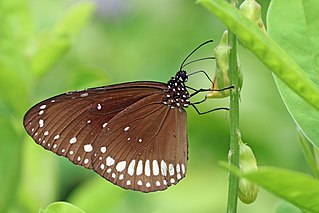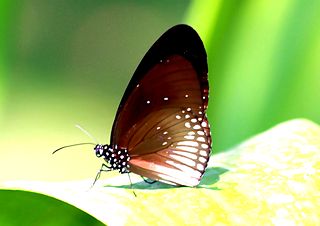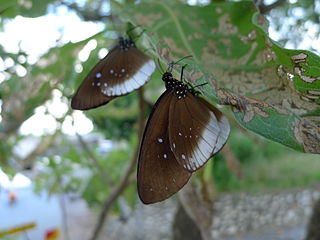
Euploea core, also known as the common crow, is a common butterfly found in South Asia to Australia. In India it is also sometimes referred to as the common Indian crow, and in Australia as the Australian crow. It belongs to the crows and tigers subfamily Danainae.

Hypolimnas bolina, the great eggfly, common eggfly, varied eggfly, or in New Zealand the blue moon butterfly, is a species of nymphalid butterfly found from Madagascar to Asia and Australia.

Euploea is a genus of milkweed butterflies. The species are generally dark in coloration, often quite blackish, for which reason they are commonly called crows. As usual for their subfamily, they are poisonous due to feeding on milkweeds and other toxic plants as caterpillars. The latter are aposematically colored to warn off predators from eating them, and the adult butterflies are often mimicked by unrelated species which are not or less poisonous.
Astygisa is a genus of moths in the family Geometridae.

Euploea alcathoe, commonly known as the no-brand crow, Eichhorn's crow or striped black crow, is a common butterfly found from India to Borneo, and in the Moluccas, New Guinea and Australia. It belongs to the crows and tigers subfamily of the Nymphalidae.

Ichneutica morosa is a moth of the family Noctuidae. It is endemic to New Zealand and is found in the southern parts of the North Island and throughout the South Island. I. morosa is common in the eastern parts of both those islands and also in Fiordland. I. morosa can be found from altitudes ranging from lowlands to the alpine zone. I. morosa is absent from the range of its closely related species I. mustulenta, that is from the northern North Island. The larvae of I. morosa are known to feed on Poa astonii and also on other Poa species including introduced species. As well as its standard form the adult moths have a grey colour morph with the head and thorax being a grey and mottled brown, and the forewing being a pale greyish ochreous to a deep brown, suffused with grey. I. morosa can be confused with I. mustulenta and I. lignana. Adults are on the wing from November to April.

Euploea camaralzeman is an Indomalayan species of danaine butterfly.

Euploea phaenareta, the giant crow is a butterfly in the family Nymphalidae. It was described by Johann Gottlieb Schaller in 1785. It is found in the Indomalayan realm and the Australasian realm.

Euploea boisduvali, is a butterfly in the family Nymphalidae. It was described by Hippolyte Lucas in 1852. It is found in the Australasian realm

Euploea wallacei, is a butterfly in the family Nymphalidae. It was described by Cajetan Felder and Rudolf Felder in 1860. It is found in the Australasian realm The name honours Alfred Russel Wallace.

Euploea climena is a butterfly in the family Nymphalidae. It was described by Caspar Stoll in 1782. It is found in the Indomalayan realm and the Australasian realm.

Euploea modesta, the plain blue crow, is a butterfly in the family Nymphalidae. It was described by Arthur Gardiner Butler in 1866. It is found in the Indomalayan realm and the Australasian realm.

Euploea stephensii is a butterfly in the family Nymphalidae. It was described by Cajetan Felder and Rudolf Felder in 1865. It is found in the Australasian realm.

Euploea westwoodii, or Westwood's king crow, is a butterfly in the family Nymphalidae. It was described by Cajetan Felder and Rudolf Felder in 1865. It is found in the Celebes in the Australasian realm.












